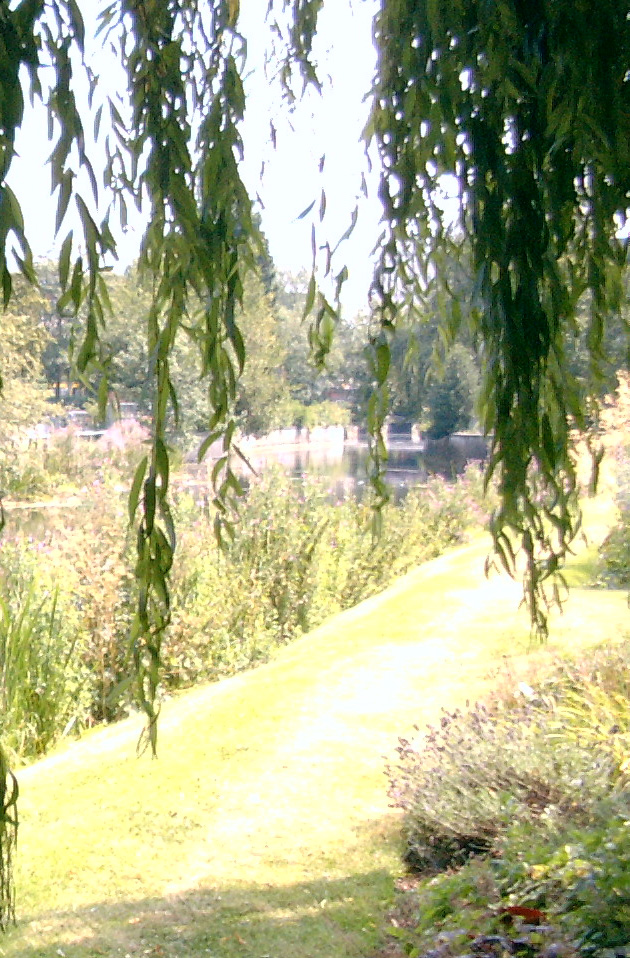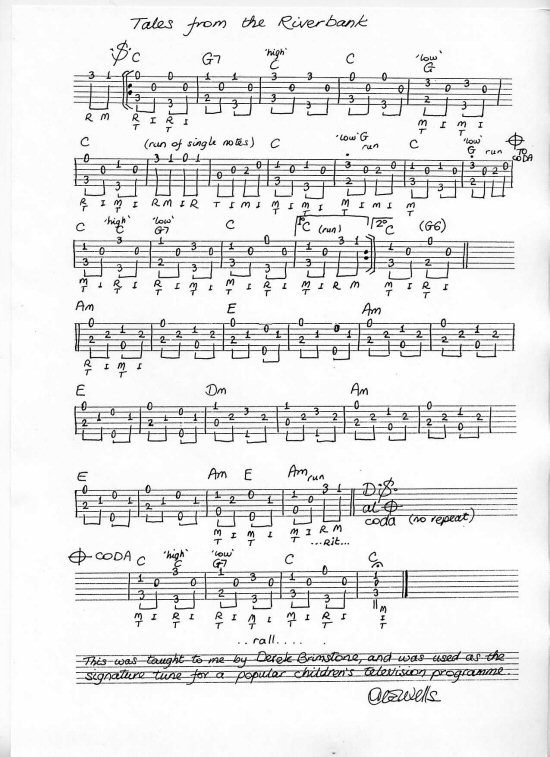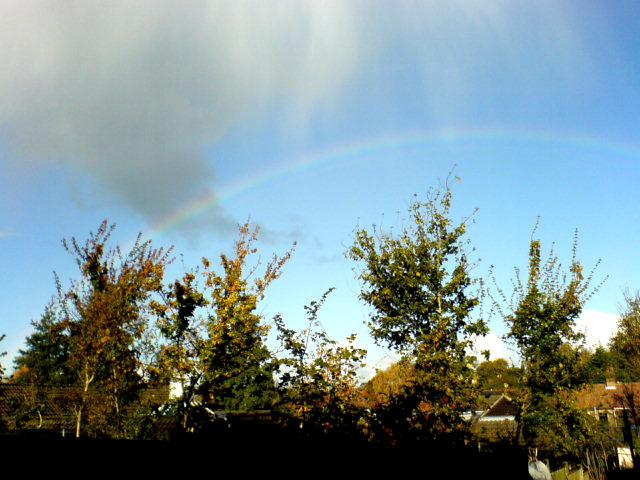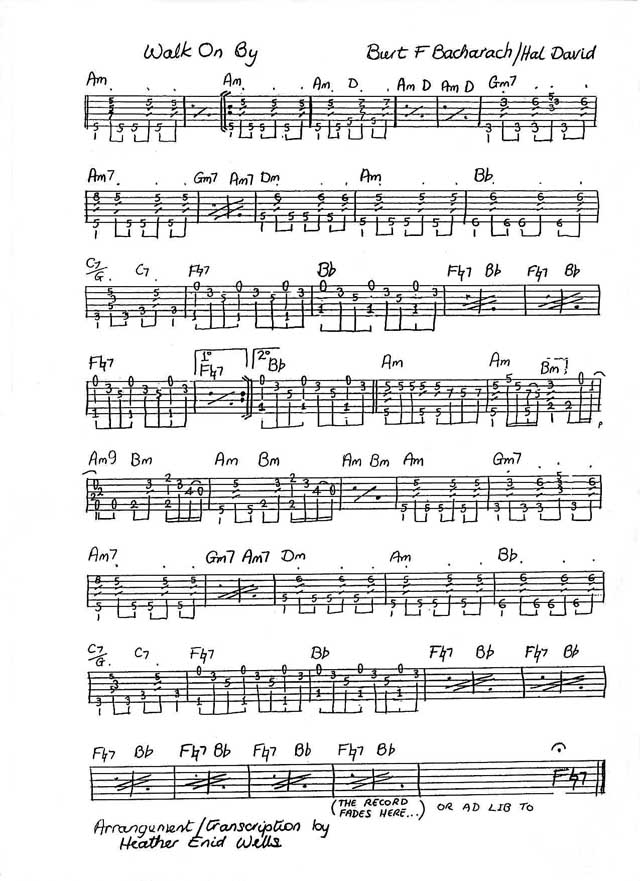Secret Tabs!
You've done well to find this page, as it's quite well
hidden (or so I thought).
I used to do a lot of teaching, and it seems a shame now to dump all the
tabs that I spent so many hours writing out. So I've decided to give them
away on this page. They are all my own arrangements, and vary considerably
in difficulty.
Because these are all songs to which I do not own the copyright, there
are no recordings. And that, of course, is why this page is secret.
As always here on Travelling Records, these jpg images are completely
FREE. Just right-click on the tab-sheet, select "Save Picture As",
and find a suitable folder on your computer in which to save the tab.
You can then resize and print it. And play it. That usually takes a bit
longer!
In an English Country Garden
The photo was taken in my own garden in the... err... City...
The numbers above the tab refer to fretting-hand fingers, and below refer
to plucking-hand fingers. Numbers on the lines show at which fret each
note is held down, the lines being strings. There are fuller instructions
on the Simplicity page.
_________________________________________________________
Gipsy Woman
This song uses Scratch Picking technique, the melody being
played by the thumb (T) on the lower-pitched strings, accompanied by the
scratch and pluck of the R (or use M if you prefer) and I-fingers (ring,
or middle, and index) filling in the spaces. The scratch is a downward
movement of the ring-finger, brushing over the treble strings with the
back of the nail. It doesn't have to strike three strings exactly, it
can hit two, three or four at random in this style of playing. Then the
index finger comes up in the opposite direction with its nail (if you
use them) striking from under string 1.
Timing: the horizontal lines, or beams, joining the tails of the notes
show how long each note lasts before the next one needs to be sounded.
But rather than trying to work that out mathematically, all you need to
remember is that a single beam says "Dum" and a double one says
"Diddy".
So the intro goes "Dum diddy diddy diddy, Dum diddy dum dum".
H means hammer-on, and the hammered note isn't played by the plucking
hand - it's the note before the hammer that is hit by the thumb.
In this song that's always an open string. Then finger 2 (fretting
hand) comes down on it, hitting it against fret 2 with enough force
to keep it ringing and the note to change. Be careful to keep this in
tempo, as the tendency is to try to play it too quickly before the string
loses its energy! Play it slowly until you can play it smoothly with the
timing right and, by the time you can play it up to speed, the note will
ring plenty long enough.
In the same way, P means pull-off, whereby the pulled-off note isn't hit
by the plucking hand. The note before the pull-off is hit to sound it,
but then the finger fretting that note (finger 2 in this song) comes
off smartly whilst the note is still ringing, giving the string a little
pluck as it goes. Again, this needs to be in tempo and not rushed ahead
of the beat.
Navigation: The first two bars are the intro and the first two notes of
the tune. Then there's a double bar-line to indicate the start of the
verse section, with dots to indicate that this is a repeated section.
As you can see, it's played four times, with different endings -
the first ending is played the first and third times through, each time
returning to the beginning of the verse again where you see the matching
dots. After the fourth ending, carry on into the second half of the song,
which is actually the Middle8 and the final verse-section. If you want
to sing more verses, just leave out the last two bars and go back to the
intro. Repeat all as before.
_________________________________________________________
Imagine
_________________________________________________________
Tales from the Riverbank

Photo by the late Rick Hayward

_________________________________________________________
Over the Rainbow

_________________________________________________________
Love is All Around
____________________________
House of the Rising Sun
__________________________
Walk On By
This arrangement imitates as many as possible of the elements
on the recording by Dionne Warwick - brass, piano, bass, etc. -
but it doesn't include the melody, it's just an accompaniment for singing.
The little diagonal marks instead of numbers in the tab just mean keep
the chord the same and strike those strings marked. I've put in the top
line most of the time. The dots over a lot of the notes mean those notes
are staccato, i.e., cut short.
This is quite a difficult thing to play, most of it is bar-chords, and
there is a very big stretch on the Fmaj7 to Bb bars!

__________________________
Tangerine Puppet
Donovan is more well known for his songs and his singing, and doesn't usually get enough credit for actually being a very good guitarist. He wrote this pretty instrumental, which isn't hard to play but sounds as if it is!
________________________________________________________
Running from Home
An early song from the late Bert Jansch. Everybody I knew wanted to play like Bert Jansch, John Renbourn and Davy Graham, and so did I! This isn't hard to play (well, as Jansch songs go!), and in any case there isn't much of it to learn ... Hmm I think this is one I wrote out a VERY long time ago.
_________________________
The Time Has Come
This is based on the John Renbourn arrangement, which I
saw him play many times in the days of the Horseshoe Club, where Pentangle
were the host band, with guests such as Ralph McTell, Sandy Denny, Alexis
Korner, Wizz Jones, Dorris Henderson, John Martyn, Roy Harper, Al Stewart,
etc. every Sunday evening.
I was not Pentangle's guest, but I used to play there during the interval -
and get paid for it! I think they went to the bar while I was on ...
_________________________
The Wild Flying Dove
Quite easy clawhammer here, or Cotten-picking if you prefer
to call it that. This style was named after Elizabeth Cotten, who wrote
the well known song Freight Train when she was just eleven years
of age. But Elizabeth was left-handed, and her brother, whose guitar (and
banjo ...) she would take down from the wall and play when he wasn't
looking, was right-handed, so she wasn't playing this style in the way
we all play it today. She turned the guitar upside down, Hendrix-style,
and plucked the tune with her left thumb and the bass with her fingers,
whereas most of us, including me, play the tune with our fingers and alternating
bass strings with the thumb.
There is a little bit of counterpoint in here, which is slightly tricky,
however, once you have it in your fingers you can use it in any tunes
where the changes are the same. You'll see a few dotted lines above the
tab in the second bar of the second line, and the first bar of the fourth
line. The chord only lasts to the end of the dotted bit, then the fingers
play the tune and the thumb plays a bass run against it. The first counterpoint
goes from C to G (the 'low' is just what clawhammer guitarists use to
distinguish different fingerings), and the second one comes from G back
to C.
_________________________
Try for the Sun
Another pretty old one by the look of it, but I think it
is more or less legible ... This has some similar counterpoint bars
as The Wild Flying Dove - in the second line against the
words "boy and", and in the fourth line behind "tears in
our". Also in the last line, "try for the". But there are
lots of places you can put it in if you like, and of course, rather than
overdo it, you can always leave the counterpoints out and play those bars
like any other 'low'-G-to-C bar.
You will also notice some places where you hammer on the whole F-chord.
This is not played as a bar-chord but with your fretting-hand thumb round
the side of the neck, just catching string 6 down on to the first
fret with that little flabby bit of flesh that protrudes on the inside
of your thumb when you bend it. Don't try to put the whole of your thumb-joint
round the neck and hold down the string with the full pad of your thumb,
because I doubt you'll get it on with enough force to get the hammer-on
if you do. But feel free to prove me wrong!
The F-chord is well named for people who haven't been playing long, whether
you play a bar-F or, as here, a thumb-F. A hint to get strings 1
and 2 to sound clearly, as both are held down by finger 1, is to
put finger 1 diagonally rather than straight across those two strings.
Try putting the centre of the tip of finger 1 exactly where fret 1
and string 2 cross. This sort of thing is much easier to play cleanly
if you are using a capo, although you will have to sing a little higher ...
_________________________
Silent Night
This is extremely simple, but may feel quite alien to some
practised guitarists, as it doesn't use standard shapes and often the
strings to be plucked are not the ones your hand is expecting!
It would have fitted well into my Simplicity
Suite if it had been written by me and, although I think it's
probably out of copyright by now, it fits OK here, too.
I should have my tab for Streets of London somewhere but can't
find it at the moment ... when I do, I'll put it up on this page.
________________________________
More FREE Tabs
My first album was entitled Different
Windows, and you can click on that title for a page with tabs,
track notes, lyrics and links to recordings, as the CD is sold out.
My second album, with ten songs and two instrumentals, is entitled Sleeping
Dogs Never Lie, and The Simplicity
Suite, which consists of seven very easy instrumentals, comes
as a bonus on the same disc.
Some additional tracks can be heard via this SoundClick
music page and tabs and links for them will appear here on Travelling
Records in due course.
If you are having difficulty printing off these tabs, please email
and they'll be sent to you free of charge.
All constructive comments on the tab are welcome. Please visit again as
I hope soon to put up some tabs for some more of my arrangements of well
known songs and instrumentals.